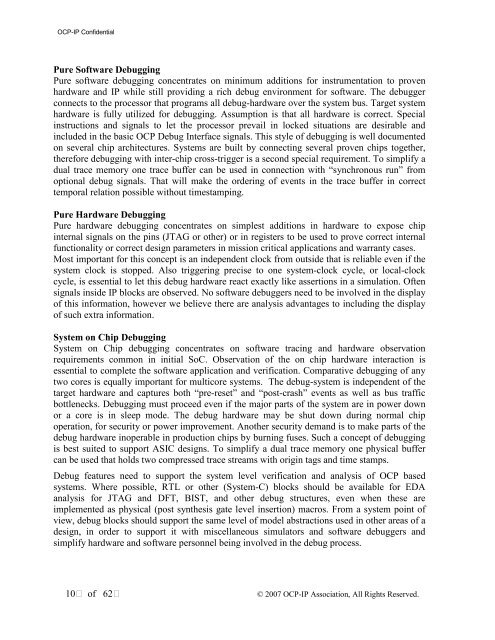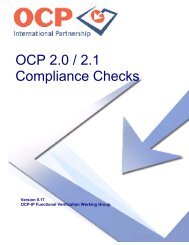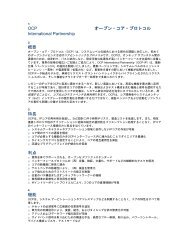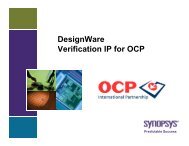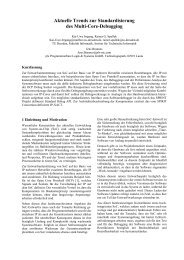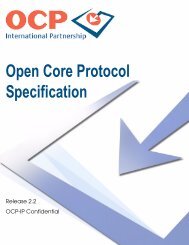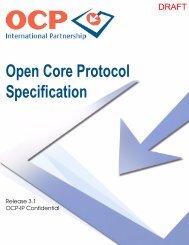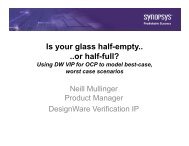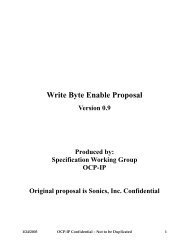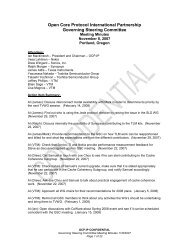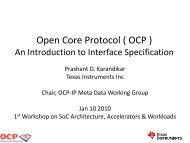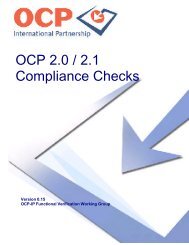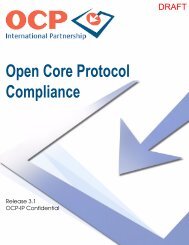Open Core Protocol Debug Interface Specification rev 1.0 - OCP-IP
Open Core Protocol Debug Interface Specification rev 1.0 - OCP-IP
Open Core Protocol Debug Interface Specification rev 1.0 - OCP-IP
Create successful ePaper yourself
Turn your PDF publications into a flip-book with our unique Google optimized e-Paper software.
<strong>OCP</strong>-<strong>IP</strong> Confidential<br />
Pure Software <strong>Debug</strong>ging<br />
Pure software debugging concentrates on minimum additions for instrumentation to proven<br />
hardware and <strong>IP</strong> while still providing a rich debug environment for software. The debugger<br />
connects to the processor that programs all debug-hardware over the system bus. Target system<br />
hardware is fully utilized for debugging. Assumption is that all hardware is correct. Special<br />
instructions and signals to let the processor p<strong>rev</strong>ail in locked situations are desirable and<br />
included in the basic <strong>OCP</strong> <strong>Debug</strong> <strong>Interface</strong> signals. This style of debugging is well documented<br />
on several chip architectures. Systems are built by connecting several proven chips together,<br />
therefore debugging with inter-chip cross-trigger is a second special requirement. To simplify a<br />
dual trace memory one trace buffer can be used in connection with “synchronous run” from<br />
optional debug signals. That will make the ordering of events in the trace buffer in correct<br />
temporal relation possible without timestamping.<br />
Pure Hardware <strong>Debug</strong>ging<br />
Pure hardware debugging concentrates on simplest additions in hardware to expose chip<br />
internal signals on the pins (JTAG or other) or in registers to be used to prove correct internal<br />
functionality or correct design parameters in mission critical applications and warranty cases.<br />
Most important for this concept is an independent clock from outside that is reliable even if the<br />
system clock is stopped. Also triggering precise to one system-clock cycle, or local-clock<br />
cycle, is essential to let this debug hardware react exactly like assertions in a simulation. Often<br />
signals inside <strong>IP</strong> blocks are observed. No software debuggers need to be involved in the display<br />
of this information, however we believe there are analysis advantages to including the display<br />
of such extra information.<br />
System on Chip <strong>Debug</strong>ging<br />
System on Chip debugging concentrates on software tracing and hardware observation<br />
requirements common in initial SoC. Observation of the on chip hardware interaction is<br />
essential to complete the software application and verification. Comparative debugging of any<br />
two cores is equally important for multicore systems. The debug-system is independent of the<br />
target hardware and captures both “pre-reset” and “post-crash” events as well as bus traffic<br />
bottlenecks. <strong>Debug</strong>ging must proceed even if the major parts of the system are in power down<br />
or a core is in sleep mode. The debug hardware may be shut down during normal chip<br />
operation, for security or power improvement. Another security demand is to make parts of the<br />
debug hardware inoperable in production chips by burning fuses. Such a concept of debugging<br />
is best suited to support ASIC designs. To simplify a dual trace memory one physical buffer<br />
can be used that holds two compressed trace streams with origin tags and time stamps.<br />
<strong>Debug</strong> features need to support the system level verification and analysis of <strong>OCP</strong> based<br />
systems. Where possible, RTL or other (System-C) blocks should be available for EDA<br />
analysis for JTAG and DFT, BIST, and other debug structures, even when these are<br />
implemented as physical (post synthesis gate level insertion) macros. From a system point of<br />
view, debug blocks should support the same level of model abstractions used in other areas of a<br />
design, in order to support it with miscellaneous simulators and software debuggers and<br />
simplify hardware and software personnel being involved in the debug process.<br />
10 of 62<br />
© 2007 <strong>OCP</strong>-<strong>IP</strong> Association, All Rights Reserved.


